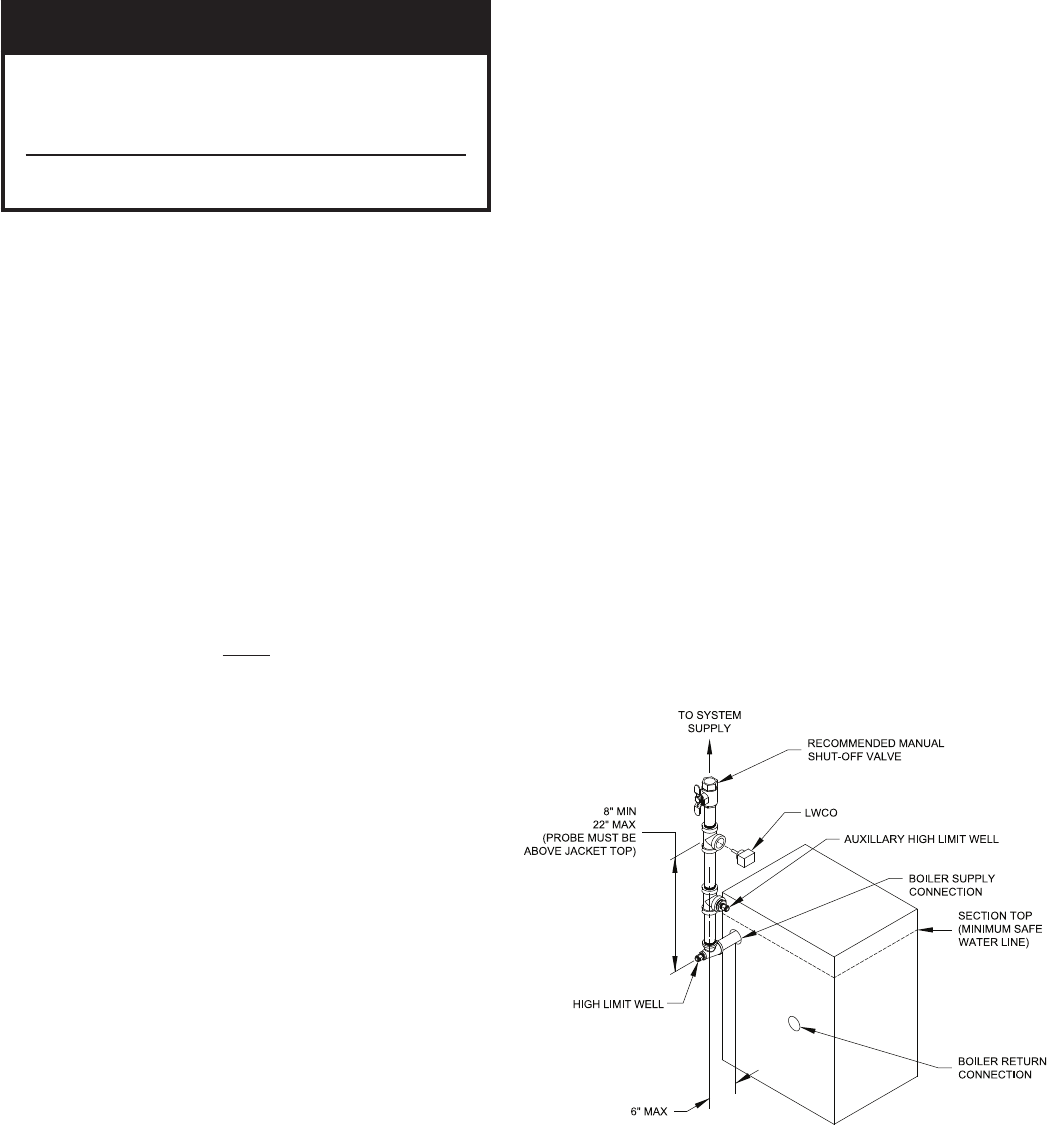Installation Guide

9
6. Installation of manual shutoff valve located above
the LWCO and the boiler is recommended to allow
servicing. Thus LWCO probe can be removed for
inspection without draining the heating system. An
annual inspection of the probe is recommended.
7. The presence of water covering properly installed
LWCO probe will cause the normally open contact
of the LWCO to close, thus providing continuity of
the 24 VAC service to the boiler gas valve. When
water level drops below probe, LWCO contact
opens up breaking 24V supply to gas valve and
preventing the boiler to re.
8. RRG Series gas hot water boilers have a “plug-in”
provision in the factory wiring that will accept an
optional 24VAC probe LWCO harness connector.
The optional LWCO kit includes a 24VAC probe
LWCO, Harness and Instructions addressing piping,
wiring and testing after installation. See Figure 9 for
wiring of the LWCO. Contact your local Rand &
Reardon Distributor for LWCO Kits.
9. RRG Series gas hot water boilers have a "plug-
in" provision in the factory wiring that will accept
an optional Auxiliary High Limit harness. The
optional Auxiliary High Limit, Well, Harness and
Instructions addressing piping, wiring and testing
after installation. Contact your local Rand &
Reardon Distributor for Auxiliary High Limit Kits.
10. Provisions are provided so that both the Optional
LWCO Kit and the Auxiliary Kit can be installed on
the same boiler.
Figure 6: Recommended Probe LWCO Location
I. Optional LWCO and Auxiliary High Limit
Installation
WARNING
DO NOT ATTEMPT to cut factory wires to
install an aftermarket Low Water Cut Off
(LWCO). Only use connections specically
identied for Low Water Cut Off.
In all cases, follow the Low Water Cut Off
(LWCO) manufacturer’s instructions.
1. A low water cutoff is required to protect a gas-red
hot water boiler when any connected heat distributor
(radiation) is installed below the top of the hot water
boiler (i.e. baseboard on the same oor level as
the boiler). In addition, some jurisdictions require
the use of a LWCO with a hot water boiler as a
redundant safety control.
It is recommended that the LWCO control is
installed above the boiler to provide the highest
level of protection. However, where the LWCO
control is approved by the LWCO control
manufacturer for installation in a high boiler tapping
of a water boiler, the use of the listed LWCO control
is permitted when it is installed according to the
LWCO manufacturer's instructions.
2. The recommended location for a LWCO on gas
hot water boilers is above the boiler, in the supply
piping. The minimum safe water level of a water
boiler is at the uppermost top of the boiler; that is, it
must be full of water to operate safely.
3. Typically, in residential applications, a probe type
LWCO is used instead of a oat type, due to their
relative costs and the simplicity of piping for a
probe LWCO.
4. Piping and ttings required to install LWCO are
eld supplied.
5. When constructing a piping tree to install LWCO
select ttings (tees, elbows etc) and nipples to have
the same size (NPT) as boiler supply connection.
At minimum, 1-1/4” tee with ¾” branch outlet is
required to connect the probe LWCO to the supply
piping. See Figure 6 for location and piping of
the LWCO. DO NOT REDUCE THE SIZE OF
NEAR BOILER SUPPLY FITTINGS AND
NIPPLES.










